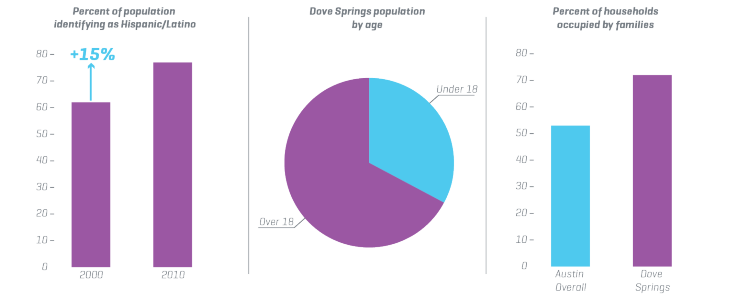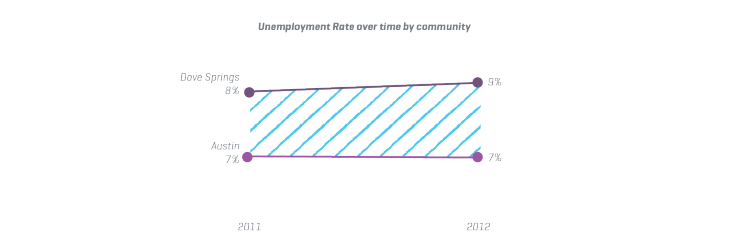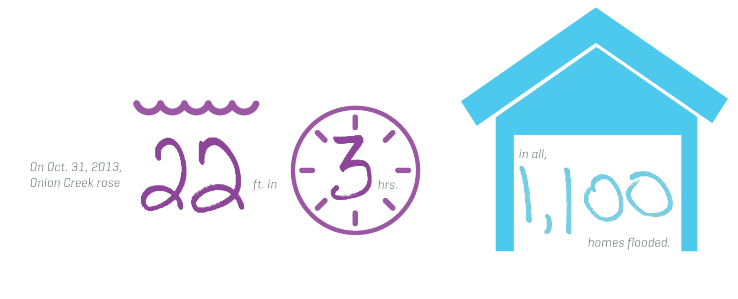As Austin grows, many neighborhoods are becoming more predominantly headed by single professionals or other household structures – but Dove Springs remains a place for families. Unfortunately, our friends and neighbors struggle with unemployment and health care challenges, and are still recovering from last year’s flooding.
Dove Springs is a younger community with many families and a growing Hispanic/Latino population

The Dove Springs community has very strong Hispanic and Latino roots. The neighborhood has largely been settled by the Hispanic and Latino population for more than a decade and currently 4 out of 5 residents claim that ethnicity.
Unlike other neighborhoods that have more seniors, students or young professionals without children, Dove Springs is full of families – which are define by the US census as a household with two or more people related by birth, marriage or adoption. A lower percentage of family households in Dove Springs are married-couple families (59 percent vs. 68 percent in Austin overall) and a higher percentage are headed by single fathers (13 percent vs. 9 percent) or single mothers (29 percent vs. 22 percent), similar to the St. John’s and Manor communities.
People who live in Dove Springs are also typically younger than other City of Austin residents with a full third of residents being under the age of 18.
Many Dove Springs residents are struggling with unemployment
Over the last couple of years, the unemployment rate for Dove Springs has been higher than the unemployment rate in the City of Austin:

Dove Springs residents are significantly more likely to have not completed high school (37 percent of Dove Springs residents vs. 14 percent of City of Austin residents), which presents challenges for adults seeking to secure a job that pays a living wage and it is reflected in the unemployment rates for the community.
As a result, 59 percent of all Dove Springs residents are low-income compared to 38 percent of residents across the City of Austin.
Housing is also an issue: 46 percent of Dove Springs households are cost-burdened, paying a third or more of their income on housing costs (40 percent in the City of Austin).
Dove Springs residents face added challenges with recent flooding and obesity
Dove Springs is the fourth highest zip code in number of calls to our Navigation Center out of all zip codes in our ten county region and the community is tenth highest in per capita calls to 2-1-1. Residents reaching out from this community have the same needs as the average 2-1-1 caller: basic needs and health services.
Yet just last year, Dove Springs residents faced additional challenges when the area was affected by flooding.

Overall, flooding destroyed or majorly affected 608 homes, and of these only 54 percent of homeowners had flood insurance, although they could be under-insured. Residents impacted by the floods are still facing disaster related issues to this day.
Moreover, a high saturation of fast food restaurants and convenient stores, coupled with the high percent of low-income residents, poses an additional challenge for the Dove Springs neighborhood.

Children’s Optimal Health has identified the Dove Springs area as an Austin community with a high concentration and proportion or obese students. Our 2-1-1 data supports this finding, with a high number of calls related to health and food needs.
As a result, the Go! Austin, Vamos! Austin initiative, with funding from the Michael and Susan Dell Foundation, is working on a series of strategies to help families get healthier.
Of these, UWATX’s Success By 6 program leads the early childhood efforts in Dove Springs, working to install shade structures for playgrounds, create community gardens and provide an early childhood health curriculum. The team is connecting with non-profit child care providers, local libraries and licensed child care providers working out of their homes, since the area has a high percentage of young children but is a formal child care desert with only 3 license child care that accept subsidies.
